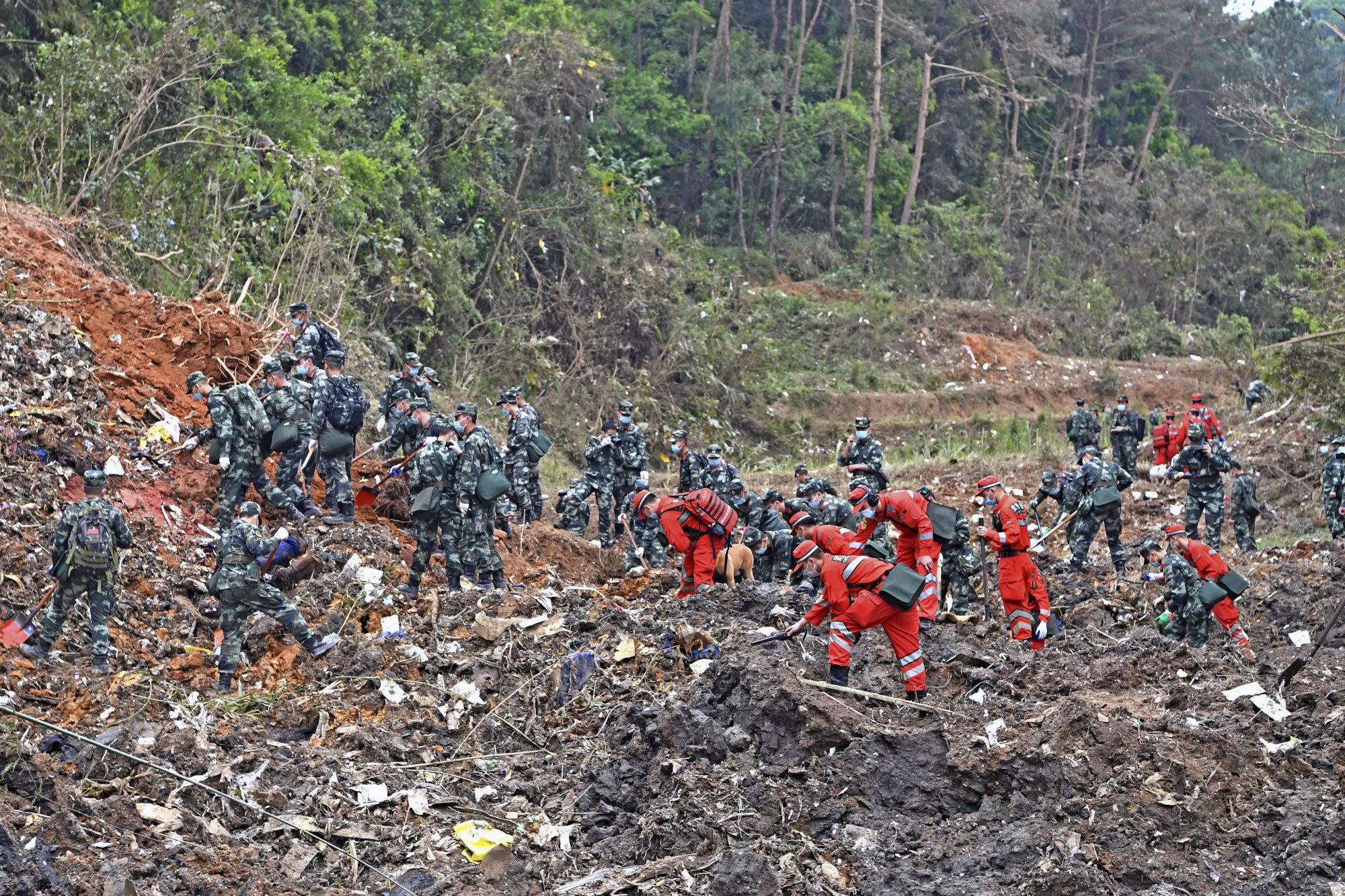
China Eastern plane crash: human remains and a black box found at site where flight MU5735 went down
- Exterior of what is believed to be the cockpit voice recorder is ‘severely damaged’ and being sent to Beijing for analysis
- It may offer clues as to what happened before the aircraft plummeted and crashed into a hillside on Monday
The Guangxi regional fire and rescue service said human remains and aircraft wreckage had been spotted after they searched an area of 46,000 square metres (500,000 square feet).
The black box – believed to be the cockpit voice recorder – was being sent to Beijing for analysis, investigators said late on Wednesday.
“Initial inspection shows the exterior of the recorder is severely damaged. The memory unit also sustained damage, but has remained intact,” said Zhu Tao, head of aviation safety at the Civil Aviation Administration of China (CAAC).
“The black box is now being sent to a civil aviation institute in Beijing for decoding. It will take some time to download and analyse the data. If the internal memory unit is damaged, it will take longer,” he said, adding that it would provide important information about the cause of the crash.
Zhu said the device had been spotted on the ground 20 metres southeast of the main crash site. He said the next step would be to look for the flight data recorder – the other black box – to piece together a full picture of what happened.
The recorders may offer clues as to why the Boeing 737-800 with 132 people on board plummeted from cruise altitude and crashed into a forested hillside near the city of Wuzhou in the Guangxi Zhuang autonomous region.
Why China Eastern flight’s ‘black boxes’ are vital to investigation
Mao Yanfeng, director of the CAAC’s accident investigation unit, told reporters earlier in the day that the weather at the time of the crash was suitable for flying and the conditions were not dangerous.
“The aircrew had maintained normal communication with air traffic control units since the aircraft took off from Kunming until the sudden drop in altitude, according to communication records,” Mao said.
Officials on Tuesday said the pilots had not responded to repeated calls from air traffic controllers when they became aware of the rapid drop in altitude.

Speaking at the same press conference earlier on Wednesday, Sun Shiying, chairman of China Eastern Airlines’ Yunnan branch, said the three pilots on board were all in good health, “had good performance and had maintained harmonious relationships with their families”.
The captain was hired to fly the 737 aircraft in 2018 and had 6,709 flying hours, while the first officer had 31,769 hours of experience, according to Sun. A third pilot was on board as an observer and had 556 flying hours.
Sun said the plane, brought into the fleet in June 2015, met the conditions for flying during checks before take-off. Its maintenance had been in line with a strict plan and its technical condition was normal and stable, he added.
China Eastern grounded its 737-800 fleet after the crash, and Sun said the airline was conducting “a large-scale safety inspection”.
Intense emotion as relatives of MU5735 passengers allowed near crash site
“The grounding of the Boeing 737-800 aircraft does not mean the model has hidden risks, but it is an emergency response after a major accident,” he said, adding that the airline’s operations would not be affected.
At the crash site in Guangxi, the search and rescue operation resumed on Wednesday afternoon after heavy rain overnight had raised fears of a landslide in the crash zone.
State broadcaster CCTV said the work was difficult because of the weather, the large area involved and the mountainous terrain, meaning the operation was depending on drones and rescue teams rather than heavy equipment. It said there were landslides on the only road leading to the main site.

The aircraft had been carrying 123 passengers and nine crew members when it disappeared en route to Guangzhou after taking off from Kunming, in the southwest, at 1.10pm on Monday.
It had been flying at almost 8,900 metres (29,200 feet) before slowing down and losing height at 2.19pm. Three minutes later, when its height was recorded at about 1,300 metres, it disappeared from the radar, according to Chinese civil aviation data provider VariFlight.
The data published by FlightRadar24 suggests the plane was at an altitude of 29,100 feet when it went into a high-speed dive at 2.20.43 pm, losing altitude at a maximum rate of about 31,000 feet per minute (348mph or 560km/h).
After climbing briefly, a second high-speed dive began, sending the plane into the ground 30 seconds later.

